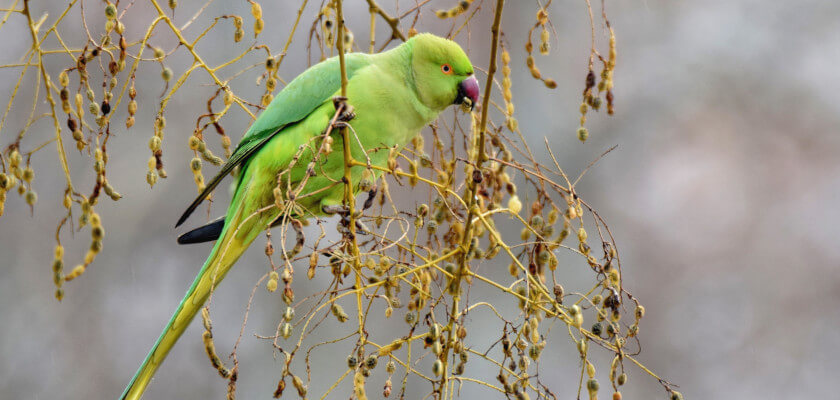If you see a fairly large green parrot outside your home window, it does not necessarily mean that it has just escaped from someone else’s farm. Perhaps you are dealing with a collar alexandretta. Although the bird comes from the regions of Central Africa, the Indian Peninsula and Ceylon, it also lives and reproduces in the wild in Poland. What is this parrot? What does he look like and what is his disposition? Can Alexandretta imitate human speech? These are just a few questions worth knowing the answer to. Our article will allow you to get to know this exotic bird closer. Read the text now!
Alexandretta – name, appearance and character
Alexandretta was caught as ornamentation in ancient times. The name of the bird comes from the name of Alexander the Great himself. Historians put forward the thesis that Alexandretta parrots were brought to Europe most likely by one of the generals of Alexander the Great, who was returning from an expedition to India in 327 BC.
What does the collar of Alexandretta look like?
The ring alexandretta is a fairly large green parrot, which is distinguished by an intense color of feathers. Here are its main features:
- the feathers are lush green;
- the bird’s beak is red;
- the body is about 40 cm long, which is a small result compared to a macaw parrot.
Alexandretta, a bird that is not afraid of change
The alexandretta parrot is hardy and easily adaptable to the surrounding conditions. If you release it from its cage and the bird escapes through the open, it has a good chance of survival. The quite aggressive disposition of this large animal means that it has no problems with finding food and defending the territory in the wild.
Podgatunki aleksandretty
The Alexandretta parrot belongs to the Psittacula family. It includes 16 different species, three of which are considered extinct. Only a part is available for sale. The most popular breeding subspecies are:
- alexandretta horn – a highly widespread species that comes from Central and Eastern Africa, but also occurs in India, Indonesia and Sri Lanka;
- alexandretta the greater – powerful bird. This green parrot is definitely larger than the previous species mentioned. It occurs naturally in Indochina, Afghanistan, Pakistan, Ceylon and Andaman. Reaches a size up to 58 cm in length (body including tail). The back of the head and cheeks of these birds should be slightly purple;
- aleksandretta rose – the smallest parakeet of this species, up to 38 cm long. She has a bluish blue head and her belly is pinkish purple;
- of the plum-headed alexandretta – these delicate-bodied birds come from Sri Lanka, India, Pakistan and Nepal. They are also small in size. Feathers are dirty green with emerald shimmering ailerons and brakes. The head is dark pink in color (purple neck). The black, narrow collar on the neck is also characteristic of this subspecies;
- Yellow-bellied alexandretta – with a yellow belly (as indicated by the name);
- Chinese alexandretta – a species of large mountain parrot that is native to China. This bird can be up to 50 cm long. He has a green back and black spots on his cheeks. The head of the parrot is bluish-purple, and the breast, belly, and feathers under the bird’s wings are bluish-gray.
Aleksandretta obrożna – breeding
This pet is intelligent without a doubt. It can be taught to imitate the sound of the human voice, so it will “speak”. A parrot raised in the company of a human becomes easily accustomed and becomes attached to its guardian. If it is bred as a single cage at home, it quickly begins to treat its owner as a mate.
There are no major obstacles for you to breed a ringed alexandretta in your home. The breeding of this bird must, however, be organized in an appropriate manner. Young parrots (at most a few months old) do the best here.
Alexandretta parrot – cage
This bird requires a suitable metal or welded mesh cage. In the case of a collar bollard, the wooden cage is omitted, because the bars would be chewed quickly. This parrot has a strong beak.
These animals are active and require a run of at least 4.5 meters in length. You can put an aviary outside (near the house terrace or even on the balcony). Remember that it must be well built-up.
In a parrot’s cage, Alexandretta can also find:
- swings;
- pine cones and pieces of wood;
- ropes;
- ladders;
- pool.
Alexandretta can be loud …
You already know how to satisfy this bird’s need for activity. It is essential to create a spacious place to fly and play. In addition, it is a noisy and exceptionally loud bird, which can be troublesome for the household members, especially for the neighbors. If you live in a block of flats, then consider if those nearby will be able to tolerate the noises.
Can Alexandretta stay home alone?
Do not leave the Alexandretta parrot without company for a long time. You should spend at least 2-3 hours a day with her. Otherwise, the bird may be depressed and even nervous and aggressive. Keep this in mind, as sometimes such behavior becomes even more serious problems.
The parrots we write about live up to 20 years in captivity. By adopting such a pet, you are taking on a commitment for many years, so make your decision without rushing.
The diet of the alexandretta parrot
What does the ringed alexandretta parrot eat? The basis of the pet’s diet is fruit. These include:
- apples;
- oranges;
- bananas;
- grenades;
- cactus fruit;
- pears.
The menu consists of 30% fruit. Additionally, you should give your pet fresh vegetables (including celery, carrots and peas) as well as groats, corn and various grains. For convenience, you can choose a ready-made mixture – food for the parrot alexandretta.
Alexandretta parrot – price
How Much Does A Ringed Alexandretta Cost? The price is not particularly high, because you have to spend about PLN 200. However, remember that the best stained birds may be more expensive.
Problems related to the spread of alexandretta in Poland
In the south of Poland, in the northern part of the Czech Republic and in Germany, these colorful birds are more and more often found in nature. They occupy the hollows of other birds, e.g. woodpeckers and hoopoes. They are resistant to temperature differences, so they can live in Poland and reproduce all year round. In 2018, the first Alexandretta breeding ground in our country was discovered. The problem is that this species of parrot may, to some extent, threaten the development and even existence of other bird species in Poland.
As you can see, the parrots described by us live not only in the homes of enthusiasts of exotic species. Is it possible to somehow stop their expansion in the wild? The alexandretta parrots that live in the wild in Poland probably come from the breeders who escaped, and it is not possible to tame them at present. However, you have options in this last matter if you are buying a pet. However, remember to keep an eye on the parrot and, above all, to ensure its proper conditions and freedom.


